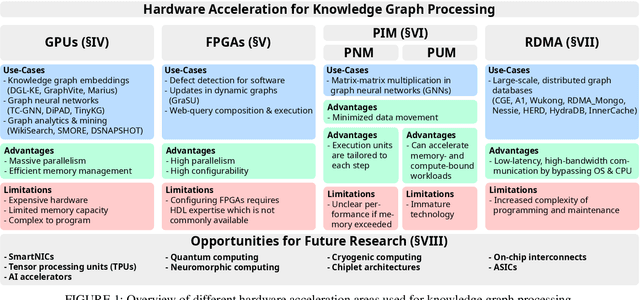Raghavendra Kanakagiri
Hardware Acceleration for Knowledge Graph Processing: Challenges & Recent Developments
Aug 22, 2024
Abstract:Knowledge graphs (KGs) have achieved significant attention in recent years, particularly in the area of the Semantic Web as well as gaining popularity in other application domains such as data mining and search engines. Simultaneously, there has been enormous progress in the development of different types of heterogeneous hardware, impacting the way KGs are processed. The aim of this paper is to provide a systematic literature review of knowledge graph hardware acceleration. For this, we present a classification of the primary areas in knowledge graph technology that harnesses different hardware units for accelerating certain knowledge graph functionalities. We then extensively describe respective works, focusing on how KG related schemes harness modern hardware accelerators. Based on our review, we identify various research gaps and future exploratory directions that are anticipated to be of significant value both for academics and industry practitioners.
Motif Prediction with Graph Neural Networks
Jun 05, 2021


Abstract:Link prediction is one of the central problems in graph mining. However, recent studies highlight the importance of higher-order network analysis, where complex structures called motifs are the first-class citizens. We first show that existing link prediction schemes fail to effectively predict motifs. To alleviate this, we establish a general motif prediction problem and we propose several heuristics that assess the chances for a specified motif to appear. To make the scores realistic, our heuristics consider - among others - correlations between links, i.e., the potential impact of some arriving links on the appearance of other links in a given motif. Finally, for highest accuracy, we develop a graph neural network (GNN) architecture for motif prediction. Our architecture offers vertex features and sampling schemes that capture the rich structural properties of motifs. While our heuristics are fast and do not need any training, GNNs ensure highest accuracy of predicting motifs, both for dense (e.g., k-cliques) and for sparse ones (e.g., k-stars). We consistently outperform the best available competitor by more than 10% on average and up to 32% in area under the curve. Importantly, the advantages of our approach over schemes based on uncorrelated link prediction increase with the increasing motif size and complexity. We also successfully apply our architecture for predicting more arbitrary clusters and communities, illustrating its potential for graph mining beyond motif analysis.
 Add to Chrome
Add to Chrome Add to Firefox
Add to Firefox Add to Edge
Add to Edge